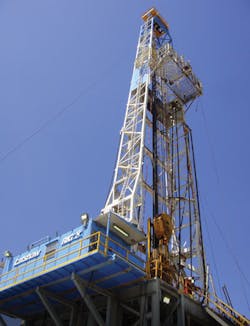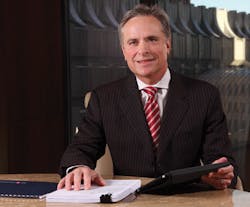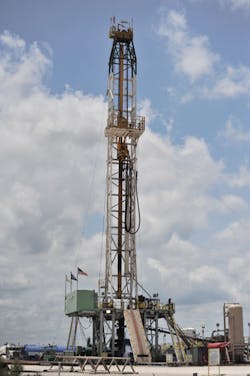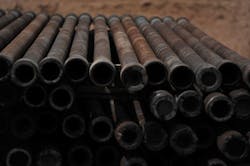Goodrich strives for robust growth and improved shareholder value
Goodrich Petroleum (GDP) capitalizes on increasing oil production in the Eagle Ford
OIL & GAS FINANCIAL JOURNAL: Fiscal 2010 was a busy and productive year at Goodrich Petroleum. You continued to develop your prospective acreage for the Haynesville and other formations in East Texas and northern Louisiana, and you built a new position in the prolific Eagle Ford Shale. Start by telling us about your gas operations in East Texas and Louisiana.
ROBERT TURNHAM: Yes, 2010 was a challenging, yet meaningful year for Goodrich Petroleum, with significant accomplishments. Even though the service industry was very tight, we were able to grow production volumes to a record level. Our gas hedges and de-levered balance sheet allowed us to weather the storm caused by low natural gas prices. Downturns force you to focus on costs as well, and we were successful in reducing our operating cost structure by half. And perhaps most importantly, we made a decision about a year ago to acquire a presence in an oil basin that would allow us the opportunity for commodity diversification and the ability to shift capital where we saw superior rates of return. We identified the Eagle Ford Shale as the play that best fit what we were looking for, and were able to put together about 40,000 net acres at a very attractive price of $1,650 per acre.
OGFJ: Your Shelby Trough acreage in East Texas spans nearly 28,000 net acres. In addition to positive Haynesville Shale results in the area, the acreage is also prospective for the Bossier Shale. How do you plan to develop this area?
TURNHAM: Our initial development plans in the Shelby Trough will focus on the Haynesville, the deeper horizon. Our current plans are to spend around $60 million this year drilling and completing wells in the trend, although we could shift some of that capital to one of our areas with more oil exposure. Our unitization efforts for the Haynesville will allow us to hold the Bossier Shale rights also, in that it sits above the Haynesville. We are excited about the Bossier potential over our block and have completed our initial Bossier discovery, the R. Dean 2H well, in Shelby County. Our current plans are to develop the Bossier at a later date once we have unitized more of our acreage from Haynesville development, and hopefully in a more robust gas price environment.
About half of our 28,000 net acres in the trend has a continuous development provision built into the lease, which provides for a more orderly development of the acreage, with less pressure to drill it or lose it. With this flexibility we can pair timing of development with gas prices, thereby locking in more favorable rates of return. Our core Haynesville acreage in North Louisiana, along with this acreage block in the Shelby Trough, are extremely valuable assets for the company, and we expect to accelerate development of this acreage in the near future once gas prices return to a more normal level.
OGFJ: Goodrich's per-unit expenses continue to decrease. How is Goodrich leveraging this as it grows production in Texas and Louisiana?
TURNHAM: We have made great progress in reducing our cost structure, with current lifting costs running about half of where they were two years ago. With our lease operating expenses per unit of production currently running less than $0.75/Mcfe, we are truly becoming a low-cost operator, which has been one of our goals for the company. Combine that with production volume growth of 15% to 25% this year and the expansion of our cash margins from our growing oil production and you will see strong growth in cash flow per share and better rates of return on our capital expenditures in 2011.
"We think 2011 will be a transformational year for Goodrich Petroleum. About 45% of our 2011 capex budget is being allocated to the Eagle Ford oil play due to the disparity between oil and natural gas prices."— Robert Turnham
Don, I also want to add that we continue to focus on enhancing shareholder value through lifting cost reduction efforts, along with maximizing our return on capital employed through reducing our drilling days and maximizing our completion results from optimization of frac designs. We have a track record of being an early mover in multiple plays and applying advances in technology to create better well results. Over the years, we have successfully transitioned from being a Gulf Coast operator to a vertical tight gas sand player in East Texas and North Louisiana to an exclusively horizontal drilling program with material acreage positions in the Haynesville Shale, Eagle Ford Shale, and Cotton Valley areas of Texas and Louisiana. We enter 2011 extremely well-positioned with the vast majority of our Haynesville and Cotton Valley acreage held by production, which will allow us the opportunity to transition once again, as we execute our growth plans in the oil window of the Eagle Ford shale play.
OGFJ: In addition to growing your gas projects, Goodrich is moving forward with your liquids expansion and transition efforts. How will the company prioritize between gas and oil projects in your operating regions?
TURNHAM: We think 2011 will be a transformational year for Goodrich Petroleum. About 45% of our 2011 capex budget is being allocated to the Eagle Ford oil play due to the disparity between oil and natural gas prices. We also have plans to drill two to four Cotton Valley Taylor sand horizontal wells in our South Henderson field in Rusk County (East Texas) due to the liquids yield associated with the gas. Our initial Cotton Valley Taylor sand well in the field had an initial 24-hour production rate of 10 million cubic feet of gas per day and 380 barrels of condensate, which generates an exceptional rate of return due to the liquids yield.
GDP allocates approximately 45% of 2011 capex toward growing its position in the Eagle Ford
With about half of our budget being spent in the oily and liquids-rich Eagle Ford and Cotton Valley Taylor sand areas, we are expecting our oil volumes to increase from around 2% of company-wide production in 2010 to 10% to 15% in 2011. The vast majority of our 15% to 25% projected growth in volumes in 2011 is being driven by a rapid buildup in oil volumes, which will also provide a material increase in cash flow per share for the company.
In addition to our oil plays, the Shelby Trough, where we own 28,000 net acres, will be a secondary focus area for us in 2011. The Shelby Trough wells are high-volume gas wells with reasonable economics even in this gas environment. We have very little lease pressure in the area, and only have to drill four to five wells over the next two years to maintain the leases. We see our acreage in the Shelby Trough prospective for both the Haynesville and Bossier Shale, providing us with huge reserve potential. We expect to accelerate development in the trend once gas prices return to a more normalized price.
OGFJ: Goodrich recently sold its non-core, shallow assets in the Angelina River Trend and Bethany Longstreet in East Texas and northern Louisiana, which added nearly $65 million to an already debt-free balance sheet. Is this another step forward in diversifying the company's asset base? How do you plan to redeploy the proceeds?
TURNHAM: The sale of these non-core, shallow assets does two things for us. First, the proceeds will help subsidize the 2011 capital expenditure budget of $225 million, as we expect to fund the vast majority of our expenditures for the year from cash and cash flow from operations. And, secondly, the properties that were sold were our highest LOE [lease operating expense] properties, which will further drive down our per-unit costs for 2011.
We announced closing of the transaction and receipt of approximately $65 million of proceeds on Dec. 30, 2010. As we enter 2011, we expect to fund the majority of our capital expenditure budget with cash and cash flow from operations. With nothing borrowed on our senior credit facility and a current borrowing base of $225 million, which we expect to grow throughout 2011, we are well capitalized to execute our strategy.
In the past, we have dramatically outspent cash flow due to the growth potential of our inventory. We still have the growth potential in inventory, but with the majority of our acreage now held by production, and with an expanding cash margin per dollar invested, we expect to be cash flow neutral and self funding in early 2012.
OGFJ: Many gas-weighted E&P companies have decreased their 2011 capital budgets from 2010 but are projecting increases in expected production for 2011. In December, Goodrich announced expectations to increase production in 2011 by 15% to 25% with $30 million less than you spent in 2010. How do you plan to do this?
TURNHAM: As I mentioned previously, most of our production volume growth in 2011 will come from oil development. However, even though we will have a sharp decrease in gas-directed capex in 2011, we think we can grow gas volumes marginally from high-grading our acreage and drilling more productive wells. A portion of our capital will be spent in the Angelina River Trend of the Shelby Trough, where wells have very high initial production rates, as well as drilling horizontal Cotton Valley sand wells in our South Henderson area, where gas rates are attractive and the economics are being driven with a very high condensate yield. We expect to spend roughly $30 million in the core of the Haynesville play in North Louisiana, which is quite a bit lower than in the past, in that our acreage is for the most part held by production.
OGFJ: Goodrich currently has three horizontal wells on production in the Eagle Ford with additional wells awaiting completion. How have your early Eagle Ford results compared with company expectations?
TURNHAM: We have always expected variability in the oil window of the Eagle Ford, primarily driven by depth, pressure, and geologic complexity. We have published a type curve primarily driven off of offset wells, which has an initial production rate of 550 barrels of oil equivalent per day. We think you will see some wells above the type curve and perhaps some below, but at this point we are comfortable with our projections. Based on our type curve and a completed well cost of $7.5 million, we can achieve an approximate 45% rate of return at $90 oil and $5 gas.
In addition, our South Texas acreage is also prospective for the Buda Lime formation, although it carries higher geologic and performance risk due to the play being driven off of naturally occurring fractures. The majority of our Eagle Ford trend budget for 2011 will be spent drilling Eagle Ford wells, but we do currently anticipate drilling additional Buda wells during the year. To date, we have drilled two Buda Lime wells that came in above 500 barrels of oil per day. Early cost estimates on our Buda wells are around $3.5 million, which is a good bit lower than our Eagle Ford wells due to the Buda not needing to be fracture stimulated.
OGFJ: In closing, kindly paint a picture for investors of what you believe Goodrich Petroleum's reserve base, production volumes, and areas of operations will look like in five years.
TURNHAM: The focus for 2011 is cash flow per share growth, and with execution, we feel our investors will be appropriately rewarded. With most of our oil and gas properties either held by production or subject to reasonable continuous development provisions, we have the ability to grow our production and reserves organically for the foreseeable future. We have more than 6 trillion cubic feet equivalent (tcfe) of reserve exposure currently in inventory, with a growing oil mix. For us, our growth rate on production and conversion of probable to proved reserves will be driven by allocation of capital. As we add oil volumes in 2011 and move towards a cash flow neutral position versus our capital expenditures in early 2012, we will be able to continue to grow production and reserves at an attractive rate, and most importantly, be self-funding. We are aligned with our investors, in that management and the board of directors own 28% of the outstanding shares of Goodrich. At the right time, in the right market, we expect to accelerate development further, and we have the assets that will allow for robust growth and enhanced shareholder value.
Gil Goodrich, Goodrich Petroleum vice chairman and CEO
OGFJ: Thanks for taking the time to speak with us.
More Oil & Gas Financial Journal Current Issue Articles
More Oil & Gas Financial Journal Archives Issue Articles
View Oil and Gas Articles on PennEnergy.com




